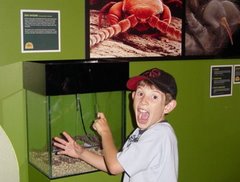Had a lovely breakfast in the redwood forest, although a bit cold it was still a great venue. Once we got back to the conference had the first plenary session.
Russell Staiff (UWS) The Challenges of Cross-Cultural Translation in an Age of Global Travel:
* Dilemmas when dealing with interface between tourism and heritage sites
* Chinese tourists are on the rise, they have visited 132 countries, 34.2 million Chinese travelled OS in 2006
* Tourism and museum/heritage places have become entangled entities – both positive and negative effects, it’s a complex relationship
* Destinations and itineraries: heritage sites get put on itineraries by others not the site itself (e.g. in the guidebooks), you suddenly become on the itinerary whether you want to or not – both in print and on the web and museums usually get prominent mentioned [although this is somewhat different for Sydney as seen as more of an outdoor city with a few icons]
* Work of sociologist John Urry on mobilities: are symptomatic of our modern social lives
* Need to understand the complexity of the cultural encounter, enormity of translating cultural knowledge to those who do not share the primary cultural affiliation of the place
* Examples given of Buddha Si Chum, Sukhothai World Heritage site and Michelangelo’s David: if you come from the west the former needs as much cultural translation as David would to an Asian tourist.
* Most Westerners get their cultural knowledge from Lonely Planet
* Discussed translation theory as way to think about what meanings tourists are making at these sites. Often we just literally translate the texts which can be unsatisfying. Therefore they tried a visual form of signage rather than reading dense texts. However still as one-way exchange couched in art history model
* Tourists are having a ‘wow’ experience but not one that they can comprehend! Despite the fact they don’t understand the experience they are still incredibly satisfied with their experience
* Appiah – Cosmopolitanism book, looked at making cultural differences legible rather than illegible by looking at shared values based on local, lived experiences of all humans, looking at commonalities
* Build content across what we all share
* The future of cross-cultural translation lies with digital technologies
Great and provocative paper Russell.
Fascinating session in the afternoon called Dark and Dangerous Tourism. Didn’t take many notes as my computer ran out of battery but have had a chance to reflect on what was discussed. Four speakers talked about museums/places that dealt with the Holocaust and slavery as well as museums in Cambodia and Colombia. We heard many facts and figures on visitation and visitors which got me thinking about a quote I quite like – “it’s not how many people visit museums but how valuable are their visits”. I hadn’t really heard anything from these sessions that looked at what visitors’ were experiencing and indeed even anything that looked at the front-end and visitors’ needs when visiting these often difficult and inaccessible places. Our research has found that visitors want museums to be more controversial and a bit out there as long as they have the capacity to comment and engage in a two-way conversation. The common thread here is the shared human stories and spirit that Russell talked about and I couldn’t help but think that taking a visitor-centred approach in this session may have added to what the speakers were saying. Anyway, here’s the link to Paul Williams’ book that I promised to post – Memorial Museums: The Global Rush to Commemorate Atrocities.
We then gave our session on visitor research and tourism. My paper will go on the INTERCOM conference website at some stage. It seemed to go quite well, given that we’d all had a 7am start we didn’t get out of the room until 6pm! I also managed to get in my two cents worth by quoting my hero Benjamin Gilman...
The long day was capped off with a lovely dinner, good food and an excellent NZ pinot. (oh, and the company was OK too!).
Subscribe to:
Post Comments (Atom)



No comments:
Post a Comment